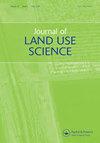Editorial introduction: women in land science
IF 3.3
4区 环境科学与生态学
Q1 AGRICULTURE, MULTIDISCIPLINARY
引用次数: 0
Abstract
Introduction We are delighted to present this collection of articles under the theme ‘Women in Land Science.’ The three guest editors and one editor in chief all decided to collate such an issue at a March 2021 virtual meeting of the journal’s editorial board when brainstorming ideas of current interest and timely need, for this journal to address. The Journal of Land Use Science was seen as a perfect location for such a special issue focus. The journal itself is a strong representation of excellence in the field as well as representation by gender as highlighted both in the journal co-editors and the editorial board composition. More specifically, the journal is co-edited by two lead scientists, Dr. Daniel Müller and Dr. Darla Munroe, one man and one woman. Of the 22 members of the editorial board, there are 12 men and 10 women serving in this role. The representation of female scientists in key research leadership positions is an important factor within the discourse on gender bias. In a recently published piece in AGU Advances (Ranganathan et al., 2021), the authors highlight the continuing persistence of inequality within academia in the geosciences. Their research finds that while 27% of faculty in academia in the US are women, this is not equal across ranks. More specifically, while 46% of assistant professors are female, this decreases to only 19% of full professors. The researchers did not have sufficient data to determine all the causes of such discrepancies especially related to higher attrition of female researchers; however, they do discuss other research that has pointed to higher female attrition linked to existing institutional cultures and policies such as very weak or inadequate childcare and maternity leave, a lack of protection from harassment, inadequate timelines to tenure, and existing cultures of sexism all leading to academic careers becoming inaccessible to women and other historically excluded groups. This article was part of a special issue in AGU Advances addressing ‘Diversity, Equity, and Inclusion in the Earth and Space Sciences.’ Thus, the current JLUS issue is timely in that we are also making space for these discussions, happening in many other fields across the social and natural sciences. According to UNESCO Institute for Statistics (UIS), less than 30% of the world’s researchers are women (uis.unesco.org 2021) and so the goal of this special issue is twofold. First, we wish to highlight some of the amazing research being conducted and led by female research scientists within the field of land-use science. In addition, we also wish to contribute to the necessary discussions on the challenges and possible deterrents for women researchers within these same fields. The fact that such an issue could also be the very first Open Access issue for the journal was extra motivation for us to put out a call and move papers through the submission, review, and revision process as quickly as possible. It is a testament to the passion and the dedication of the authors in this issue that we received such an intellectually rich set of contributions that are scientifically important, timely, and collectively can forge an ambitious agenda for the land-system science community in its efforts to broaden and diversify in the years to come. In the sections below, we first reflect on our experience and relations to gender equity in land-use science. We then briefly summarize three emergent themes from the issue: the coherence among the land science applications featured in the issue, the contours of the extant gender gap in land JOURNAL OF LAND USE SCIENCE 2022, VOL. 17, NO. 1, 1–11 https://doi.org/10.1080/1747423X.2022.2022285编辑导言:土地科学中的女性
我们很高兴以“妇女参与土地科学”为主题,介绍这一系列文章。三位客座编辑和一位主编都决定在2021年3月的期刊编辑委员会虚拟会议上整理这样一个问题,当时正在集思集想当前感兴趣和及时需要的想法,供期刊解决。《土地利用科学杂志》(Journal of Land Use Science)被认为是刊登这类特刊的最佳地点。该期刊本身是该领域优秀人才的有力代表,在期刊共同编辑和编辑委员会的组成中都突出了性别代表性。更具体地说,该杂志是由两位首席科学家Daniel m勒博士和Darla Munroe博士共同编辑的,他们是一男一女。在编辑委员会的22名成员中,有12名男性和10名女性担任这一角色。女性科学家在关键研究领导岗位上的代表性是性别偏见话语中的一个重要因素。在AGU Advances最近发表的一篇文章中(Ranganathan et al., 2021),作者强调了地球科学学术界持续存在的不平等。他们的研究发现,尽管美国学术界27%的教职员工是女性,但这一比例在各个层级之间并不平等。更具体地说,46%的助理教授是女性,而正教授中只有19%是女性。研究人员没有足够的数据来确定这种差异的所有原因,特别是与女性研究人员的高流失率有关;然而,他们确实讨论了其他一些研究,这些研究指出,女性的高流失率与现有的制度文化和政策有关,比如育儿和产假非常薄弱或不足,缺乏对骚扰的保护,获得终身职位的时间限制不足,以及现有的性别歧视文化,所有这些都导致女性和其他历史上被排斥的群体无法进入学术生涯。本文是AGU Advances关于“地球和空间科学中的多样性、公平性和包容性”特刊的一部分。“因此,当前的JLUS问题是及时的,因为我们也在为这些讨论提供空间,这些讨论发生在社会和自然科学的许多其他领域。”根据联合国教科文组织统计研究所(UIS)的数据,世界上不到30%的研究人员是女性(uis.unesco.org 2021),因此这一期特刊的目标是双重的。首先,我们希望强调在土地利用科学领域内由女性研究科学家正在进行和领导的一些令人惊叹的研究。此外,我们还希望就这些领域的女性研究人员面临的挑战和可能的阻碍进行必要的讨论。事实上,这样的问题也可能是期刊的第一个开放获取问题,这是我们发出呼吁并尽快通过提交,审查和修订过程的额外动力。这证明了作者们在本期杂志上的热情和奉献精神,我们收到了如此丰富的学术贡献,这些贡献在科学上是重要的,及时的,并且可以共同为土地系统科学界在未来几年扩大和多样化的努力中制定一个雄心勃勃的议程。在下面的各节中,我们首先回顾我们在土地利用科学中与性别平等的经验和关系。然后,我们简要地总结了本期杂志的三个新兴主题:本期杂志中土地科学应用之间的一致性,土地中现存性别差距的轮廓。1,1 - 11 https://doi.org/10.1080/1747423X.2022.2022285
本文章由计算机程序翻译,如有差异,请以英文原文为准。
求助全文
约1分钟内获得全文
求助全文
来源期刊

Journal of Land Use Science
Environmental Science-Management, Monitoring, Policy and Law
CiteScore
5.40
自引率
6.20%
发文量
26
期刊介绍:
The Journal of Land Use Science provides a central outlet for high-quality articles on theoretical and empirical aspects of land-use science at the interface of social and environmental systems. The Journal brings together an array of research perspectives at multiple temporal, spatial and social scales that contribute a better understanding of land-system dynamics and communicate scientific advances towards attaining land-system sustainability.
 求助内容:
求助内容: 应助结果提醒方式:
应助结果提醒方式:


